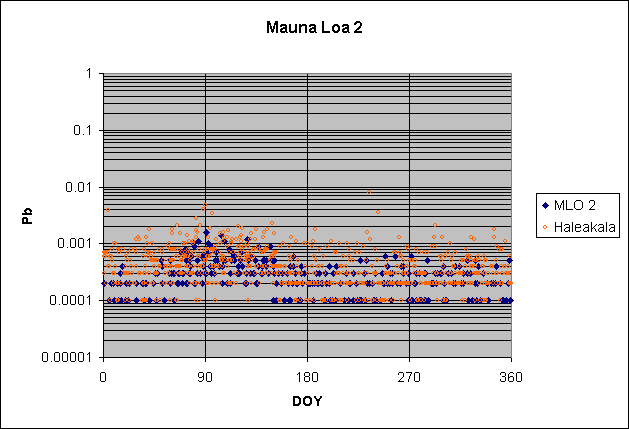
The IMPROVE data on Pb vs. Pb at Haleakala, HI
The previous series of slides, for Pb, shows that the spring
peak disappears as soon as the air passes to the east of the Rockies. It also
shows, however, that the peak is seen more clearly at some places in the West
than at others. In order to show that both these effects are due to the relative
height of the local background for Pb, I have prepared a series of slides that
show both the local Pb and my best estimate of the transported Pb. The latter is
just the concentrations from Haleakala in Hawaii.
You may be wondering why I chose Haleakala over the
better-known Mauna Loa. The choice was a difficult one, and is subject to
change. The main reason was that Pb at Haleakala showed
concentrations during the spring peak that were closer to those in western North
America than were those (lower ones) at Mauna Loa. In fact, the spring peak at
Haleakala is virtually indistinguishable from the peaks over the entire American
West, whereas the peak at Mauna Loa is lower. A second reason was that there
were twice as many samples for Haleakala as for Mauna Loa. The plots for Pb at
the two places are shown just below.

The selection of Haleakala brought with it a downside, however, for the Pb
concentrations at Haleakala are noisier than at Mauna Loa. Although much of this
may be genuine variation attributable to Haleakala's lower altitude (1500 m vs.
3400 at Mauna Loa), some of the noise may simply reflect the greater number of
samples.
A careful examination of the plots for Pb and Pb at Haleakala
will reveal that the concentrations throughout much of the West are very similar
to those at Haleakala during winter and into spring (though at least the first
half of the spring peak). Shown below is one of the clearer examples of this,
for Scoville, Idaho.
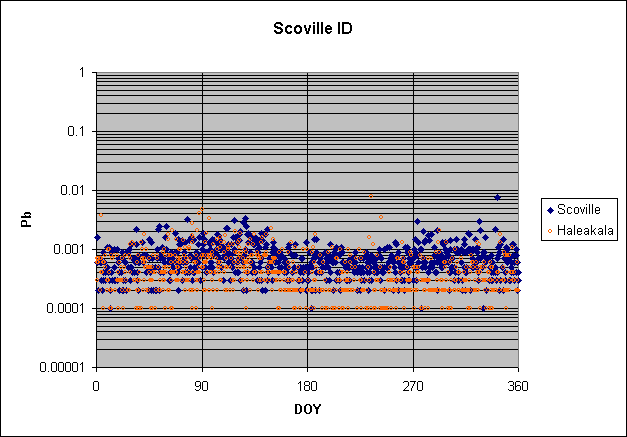
The simplest explanation for this is that the North
American Pb of winter and spring does indeed come largely from over the Pacific. But
after the spring peak is passed, the Pb falls away at Scoville (and other
western sites) less rapidly than at Haleakala (an effect that will be seen more
in more pronounced form for Si
below). That means that "local" Pb takes over in late spring, and continues to
dominate throughout the summer and fall. At the end of fall (typically in late
November or early December) the Pb at the western North American sites drops to to stable Pacific values
(with or without a preliminary fall peak) and remains there through the winter.
Is this Pacific Pb really Asian (meaning
Chinese/Korean/Japanese)? After all, that's where the air seems to be coming from. I am
not yet ready to make this leap, because we are dealing with fine
aerosol that has such a long lifetime in the atmosphere. There is nothing whatsoever
to prevent some of this Pb, or even most of it, from coming from other sources. Those sources could be west of
China/ Japan/ Korea or north of them. I also see nothing in principle to stop some of this Pb
from even being "generally northern" in origin, which means roughly polar
(like Arctic haze and its forbears). This is one of the challenges posed to the
IMPROVE set by its decision to restrict itself to fine aerosol.
East of the Rockies, background concentrations of Pb rise
enough to fall well above the Pacific/Western levels and obscure the spring
peak. You can see the effect beginning by Badlands, South Dakota:

The effect is stronger at Mammoth Cave NP, Kentucky:
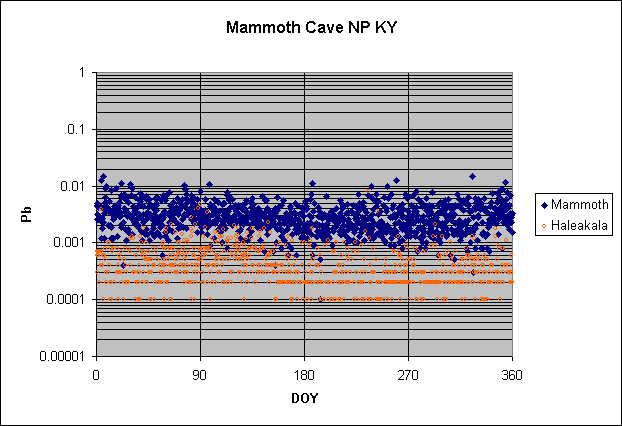
and at more-easterly locations such as Shenandoah NP, Virginia:
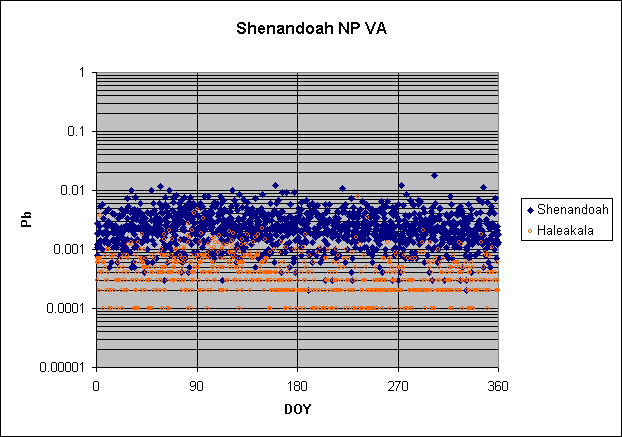
Curiously, though, there is some indication of a short Pacific-type spring peak as far to the northeast as Acadia National Park, Maine:
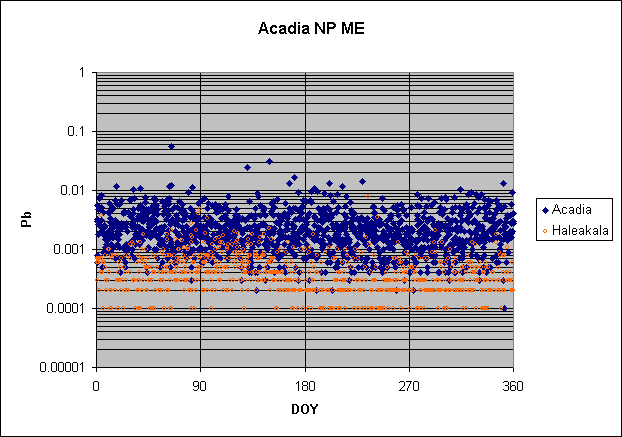
The north-central states show a spring peak for Pb, but one that comes earlier than the Pacific peak. A particularly good example is Boundary Waters, Minnesota:
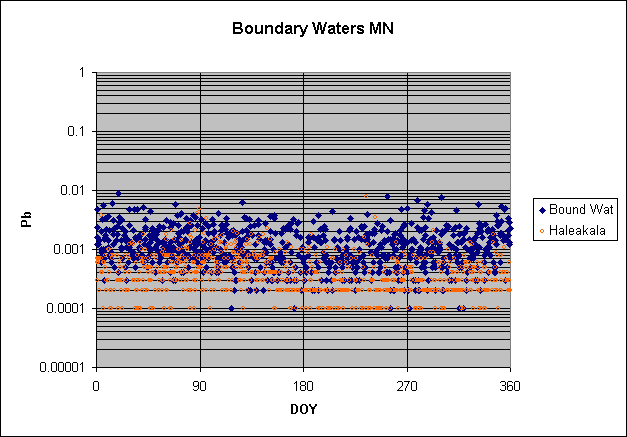
This peak follows the clearer peak for S, and is probably derived for Arctic
air heading south in spring.
Another very interesting aspect of Pb's concentration and
timing is the appearance of a spring peak in the Southeast that is surprisingly
similar to the Pacific peak in the West. Examples include the Okefenokee NWR,
Georgia, Chassahowitzka NWR, Florida, Everglades NP, Florida, and even Virgin
Island NP shown below.
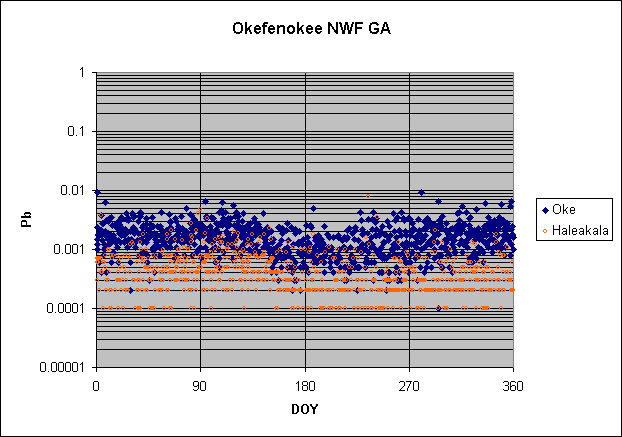
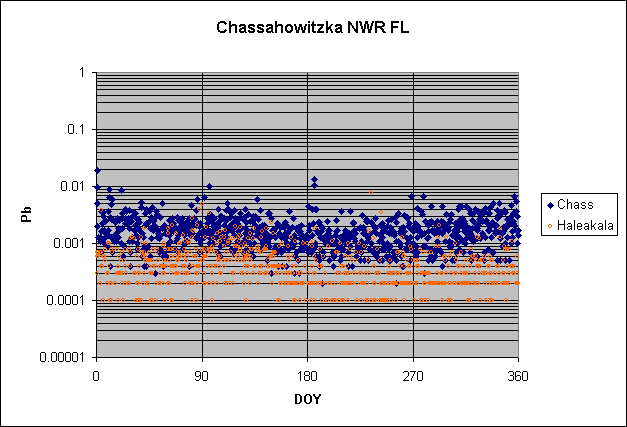
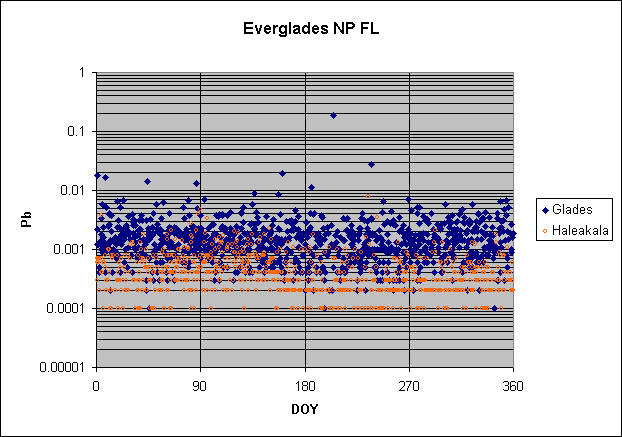
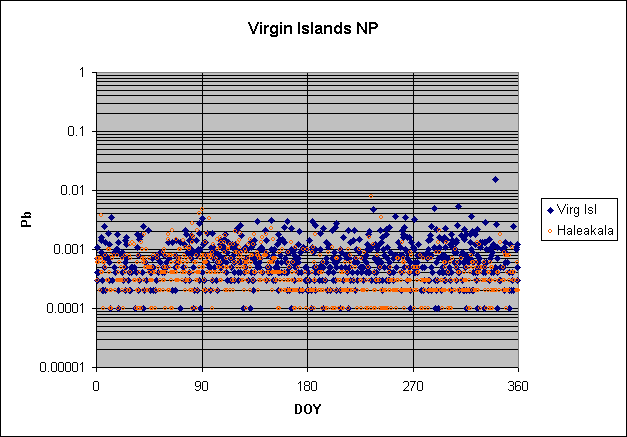
Each of these places shows a spring peak nearly identical
to the one at Mauna Loa. How can places as far away as the Virgin Islands have a
peak that matches Hawaii's? I suspect that both sites are reflecting, at least
partially, some overall condition of the springtime atmosphere.
In summary, Pb shows a spring peak throughout much of the
West that is consistent in concentration and timing with the one at Haleakala,
and so probably represents material arriving from over the Pacific Ocean. Once
this air crosses the Rockies, the peak is mostly masked by the higher background
of Pb from the more-populated eastern areas. Along the northern border, a
stronger and earlier spring peak is seen that may be linked to southward
transport of Arctic air. The American Southeast also offers indications of a
spring peak that resembles the Pacific peak, although it is unlikely that this
peak could have dominantly been aerosol from over the Pacific. It is possible
that the southeast peak represents a more general effect in the springtime
atmosphere of the Northern Hemisphere.
Slide show for Pb versus Pb at Haleakala, HI